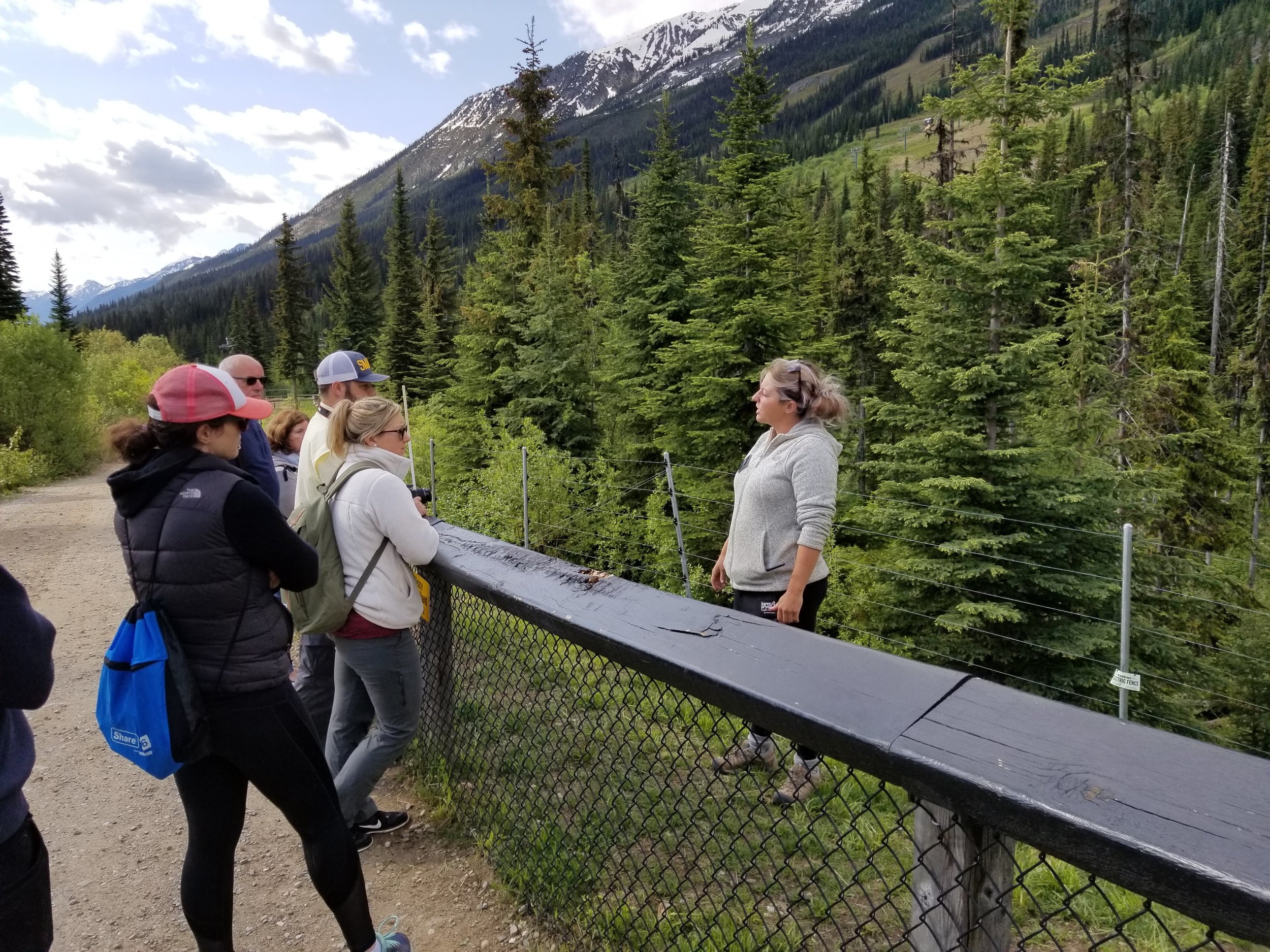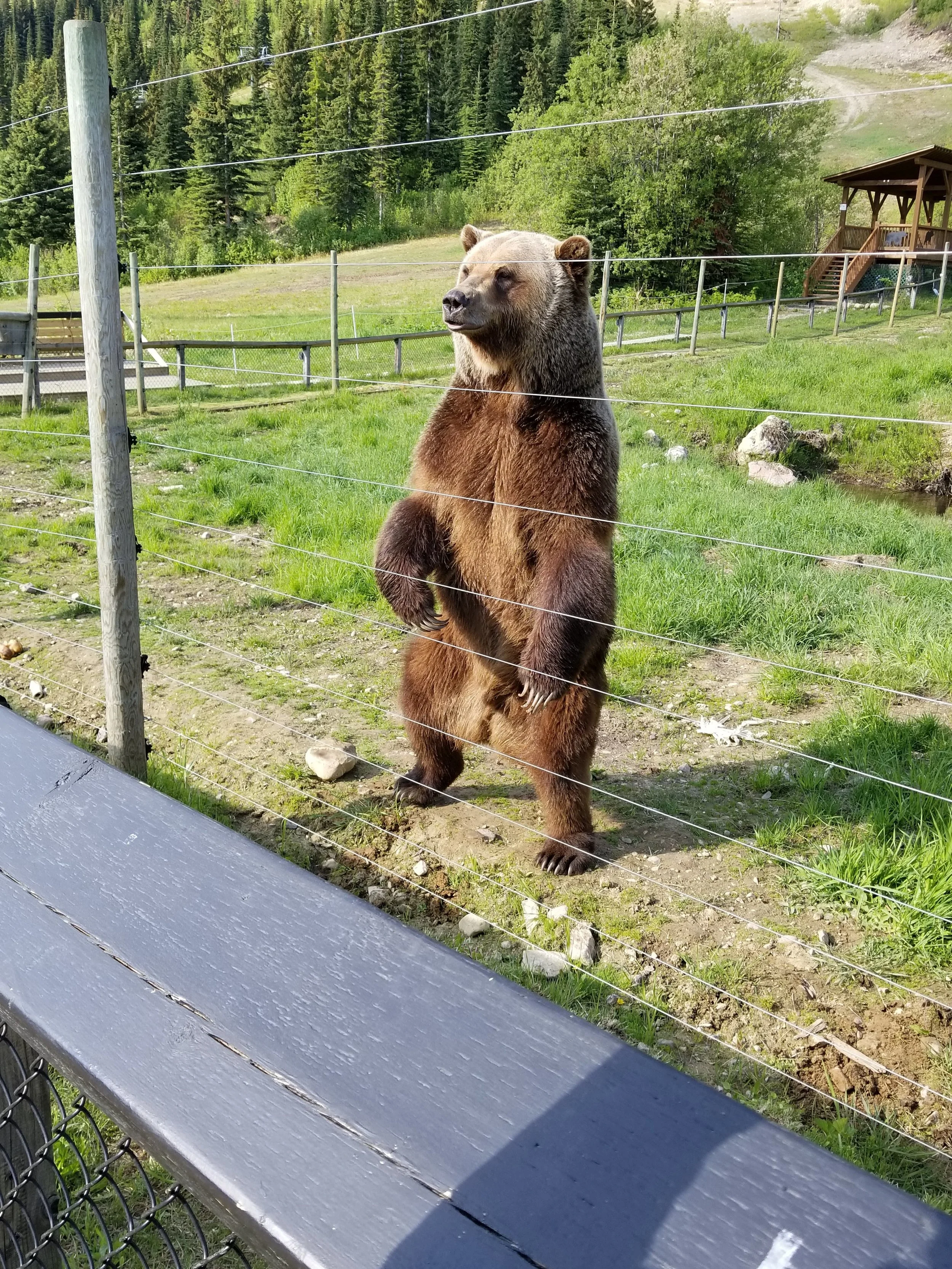Learn to Live as a Bear should Live
Meet Canada’s Boo Bear
Cowan gives visitors a glimpse into Boo’s daily life. Photo by Carrie Dow.
This warm Canadian morning I am introduced to Boo the Grizzly Bear, a resident of the Grizzly Bear Refuge on a mountainside in the town of Golden, British Columbia. He is big and burly and several shades of brown with huge, sharp claws growing several inches long off the edge of his giant paws and big incisors inside his mouth. As he eats his morning snack of corn, carrots, and yams filled with nutrition supplements, I can see the big pearls of death between chews. Despite the menacing facade, I can also see Boo’s more friendly side, his big goofy dopey side, as he half rolls/half lumbers from one snack to the next along the lower fence of his enclosure. Some birds get a little too close to his head and he swats them like flies. To see how big and healthy Boo is now compared to his beginnings is to learn the sad fate of grizzly bears in North America.
“Boo was born in 2002,” says his current handler, Refuge Assistant Manager Cat Cowan. “He came from a few hours north around Wells in the Cariboo Range. We didn’t find a wild bear here and put a fence around him. It was an unfortunate situation.”
“Boo’s mom,” she continues, “was a healthy, thriving, high-reproducing bear in that region. Now all cubs are born in the den during hibernation. While he’s over 800 pounds now, at one time he was the size of my hand. Boo’s mom leaves the den with her three beautiful cubs seeing the world for the first time in May. Then June 4, 2002, is the day that would change his life.”
Boo’s mom was foraging dandelions by a road side. According to Cowan bears are often found near roads because dandelions - a favorite food - are easily accessible.
“You’ll see moms and cubs by the side of the road so mom can forage and the cubs are found in or near the trees. Mom is able to rush them up the nearest tree if needed,” she says.
“Often we call that a ‘bear dam,’ when a bear is by the side of the road and people stop. They stop and get out of their cars and run up to bears and take a selfie. That scenario can be dangerous, not only for the person, but for the bear. The first time that happens, the bear runs into the woods. But the tenth time, the hundredth time, the thousandth time that happens, that bear doesn’t care. Highway fatalities are the number one killer of grizzly bears as well as our train tracks.”
“On that day, Boo’s mom was close to the road and people were actually being good. They were stopping a safe distance away, taking a photo from their vehicle, and moving along. A few people were monitoring the situation from a safe distance.
“This guy pulls over in his truck, gets out, and runs up to momma bear. The people watching start yelling at him, ‘leave them alone’. The guy turns and people realize he is not holding a camera, but a shot gun. He unloaded a 12-gage on Boo’s mom by the side of the highway.”
Cowan is Boo’s caretaker. Photo by Carrie Dow.
After gasps from the crowd, Cowan continued.
“What did the cubs do?” she asks for us. “One ran into the woods and was never found. The other two cubs, Cari and Boo climbed a tree and waited there for several days. They were waiting for their mom’s vocalization it was safe. It never came.”
All the visitors raised their hands for questions, but they all had the same one. Why?
“No rhyme or reason why he did it. He didn’t just take one bear out of the eco system that day, he took out all four.” According to Canadian newspaper reports, the man was fined $9000.
Cowan says then some clearer thinking humans entered the scene.
“Obviously this got a lot of media attention and that ended up saving Boo’s life,” says Cowan. “People asked, ‘what do we do with orphaned cubs? We’ve done so much with wolves, why not bears’?”
In both the US and Canada, there are rehabilitation centers for black bears, but not grizzlies.
“Black bears have a wide spread habitat and high reproduction rates and we’re helping them whereas grizzlies we’re not helping,” says Cowan. “Not to mention habitat loss. California use to have a huge population of grizzly bears. The flag has a grizzly on it! There are no more. They used to be found as far south as northern Mexico and as far east as Ontario. Now you only find them in the Pacific Northwest and Western Canadian Rockies.
“So it was either euthanize the cubs or captivity,” says Cowan.
First the cubs went to Gross Mountain Endangered Species Refuge. However, they already had two older bear cubs on only five acres of land. That is not enough territory for four male grizzly cubs.
“Kicking Horse and Gross Mountain were owned by the same company so Kicking Horse said, ‘Why don’t we try something’?”
Kicking Horse offered up land with a variety of eco systems. However, Cowan cautions that this place is not a show.
“It’s for education and research matters,” she states. “We wanted to learn if these cubs can teach themselves within a protected area how to survive. Can we see what their instinctual behaviors are compared to what their mother would be teaching them? Most importantly, to learn to live as a bear should live.”
Kicking Horse gondola floats above Boo’s habitat. Photo by Carrie Dow.
To that end, the refuge has a double fenced in area of 20 acres of alpine and sub-alpine habitat. There is a pond, a waterfall, forest, and a den in a separate enclosure next to the acreage. Cowan says there are other animals that live in the enclosure and those creatures are a source of entertainment and sometimes food.
“The biggest thing he would hunt is a marmot getting through the fence,” she says. “There are frogs, birds, insects. He has a pond, but there are only tadpoles in it, no fish.” Rangers from surrounding parks also bring in road kill animals such as elk and deer, to help them clear the highways and provide Boo some variety.
Then there was the time Boo actually caught a moose, Cowan announces laughing.
“That was an interesting work morning,” says Cowan still giggling. “We don’t want that to happen, but it does.”
“I was in training at the time,” she continues. “I come up with Ross (the manager). He said he needed to check the fence and for me to check Boo. I come to the viewing platform and some of the fence is torn up and the big wooden post was snapped. I’m thinking, ‘where’s the bear?’ I’m calling him. His big head pops up and he has a big smile on his face. I give him some grapes. I’m looking him over and he looks fine. I go back to Ross and as we’re talking we see ravens flying overhead. We lock up the isolation enclosure so we can go in and Boo walks over with a cheeky grin on his face. Sure enough, four feet to his left there was big leg sticking out of the ground. It was a 500-pound two-year-old bull moose. That was a shock!”
Bear arrived at Kicking Horse with his sibling, Cari, however, Cari developed an intestinal twist during hibernation and died as a result. Cowan says he never woke up, which left Boo alone.
“It took a toll on him,” she adds. “He ended up going to all of Cari’s favorite spots throughout the habitat. Bears are fairly solitary animals, so he continued on with life. Boo continues teaching us and we continue to learn from him. He teaches me something new every day.”
What has the facility learned about grizzlies during Boo’s tenure? Quite a bit.
“Bears are incredibly smart creatures. Smell is like vision to him. It’s how he sees the world. Right now you are looking at the bear refuge and when those memories come up, you’ll picture him playing with his landscape ball; you’re making that map in your mind. For him he makes that mental map with his nose. Olfactory maps.
“What bears need in terms of enrichment, they are on the same level as chimpanzees. The amount of activity, thinking, problem solving skills are amazing. As his caretaker, I give him lots of things to play with in his isolation enclosure while I hike through his habitat. The gondola is a great tool. I’ll drop food from the gondola spreading it throughout the habitat so he just doesn’t follow where I’ve been stepping. When he comes back in, he’ll smell where things are and add to his map. When I hide food for Boo inside the enclosure, I have to walk and remember every step I took so I can return the same way to confuse his nose as much as I can. Bear games is a big part of the job of keeping that big beautiful brain of his stimulated.That mental stimulation will induce natural foraging so he’s not just being given food. Helps with issues such as [Obsessive Compulsive Disorder] that bears in captivity can develop.”
Boo enjoying his pond. Photo by Carrie Dow.
Despite Boo’s occasion moose capture, a regular grizzly’s diet in 80% vegetarian. When Boo comes out of hibernation in May, he weighs about 500-600 pounds. He is heaviest before hibernation topping over 800 pounds. While in hibernation his respiratory rate, temperature, and humidity are also monitored. Contrary to popular belief that bears sleep during hibernation, Boo often wakes ups a few times a day during hibernation to stretch, but does not leave the den. Cowan says he does ‘yoga’ when he wakes from his sleep and rolling around on the ground in Happy Baby is his favorite pose. His blood flow to his extremities drops to about 70% during hibernation so he has to shake and stretch his arms and legs several times a day.
“Since Boo has displayed all these natural behaviors, you might be saying, ‘Why isn’t he in the wild?’ Bears have incredible memory, second to that of elephants. Boo remembers the first people who handled him, he remembers me and has been conditioned to people. He’s socialized. That is not OK for a bear in the wild. However, it allows us to see into Boo’s world, he blesses us, to see 80% to 90% of his day. If we studied bears in the wild, we’d only see 10% of their day, if you’re lucky.”
Visitors can view Boo during the summer months from May through September. The last day of September is the last day of operations to the public and staff help Boo get ready for hibernation and he typically goes to sleep in November. Cowan says that she and current Refuge Manager Nicole Gangnon care for Boo all year around. Cowan, an affable blonde from Ontario, used to work in natural parks and in human/wildlife conflict and has always worked with bears. She has been Boo’s caretaker for three years now.
“My life revolves around Boo.”
Paid public tours of Boo are given every hour from 10 AM until 2 PM Monday through Thursday and 10 AM to 4 PM on Friday and Saturday. Cowan says the best time to catch a glimpse of Boo is during morning hours when he is more active. No tours are offered at 1 PM because that is Boo’s afternoon nap time. The tours are not scripted and guides will follow Boo around his enclosure so each day is unique. For those with difficulty walking, there is a viewing stand of bleachers. If you do not see Boo on your initial visit, you can come back the next day for free. Rates are available on the Grizzly Bear Refuge page of Kicking Horse Mountain Resort website.
Boo Bear living his best life. Photo by Carrie Dow.












